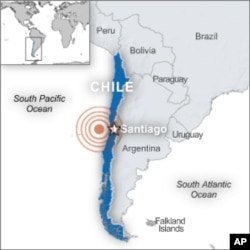A massive 8.8 magnitude earthquake rocked Chile early Saturday killing at least 122 people, toppling buildings, and triggering a tsunami warning around the Pacific "rim of fire." Cell phone communication has been knocked out across much of the country and communication has been difficult in the area where the earthquake struck.
A powerful earthquake struck Chile while most residents were sleeping early Saturday.
Reports say buildings shook and power went out in Santiago, 320 kilometers northeast of the quake's epicenter. Other parts of South America also felt the earthquake.
Chilean President Michelle Bachelet has declared a "state of catastrophe." She told a news conference emergency response teams have been deployed across the region.
Chilean officials say the death toll is expected to rise.
Several strong aftershocks have followed the quake, including one with a 6.9 magnitude.
The United States Geological Survey, which measures seismic activity, says the quake struck about 100 kilometers from Concepcion - a large city in central Chile. Randy Baldwin, a geophysicist with the U.S.G.S, says the area is located along the fault line of two large geological, or tectonic, plates. He says the area is an active quake zone.
"It is certainly one of the great quakes that have occurred here," he said. "This particular area has been known to produce large, devastating earthquakes in the past. And so the population has experienced some rather large events. The area is rather active. It's located along the boundary line between the South American plate and the Nazca plate, and along where these two plates meet one another is a zone of earthquake hazard and volcanos also."
Haiti was struck by a deadly earthquake in mid-January. That event, which registered at a magnitude of seven, struck about 10 kilometers from the Haitian capital, Port-au-Prince. At least 217,000 people were killed and more than one million others were left homeless.
Randy Baldwin, of the U.S. Geological Survey, says the nearly nine point magnitude felt by Chile can be particularly devastating.
"There was a quake back in 2004 off the coast of Sumatra that caused the big tsunami and the massive destruction in the Indian Ocean. And that was a 9.0 or larger. And this particular area is located a few hundred kilometers from where one of the largest quakes in recorded history happened back in 1960. So this particular region is known for extremely high earthquake hazard," he said.
The largest earthquake ever recorded struck the same area of Chile on May 22, 1960. The magnitude-9.5 quake killed 1,655 people and left two million homeless. The tsunami that it caused killed people in Hawaii, Japan and the Philippines and caused damage to the west coast of the United States.
But experts caution that a high magnitude alone does not necessarily correlate to a quake's deadly impact. They say a number of mitigating factors can make an earthquake deadly. These include, among other things, the location and depth of the epicenter, the density of the population in the affected area and the quality of construction and strength of the buildings and infrastructure.








